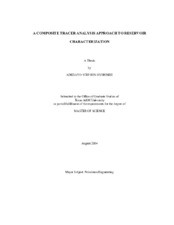| dc.description.abstract | In the quest for production optimization from established resources, there is a continual interest in secondary and tertiary recovery methods. The success of these enhanced recovery methods, however, rely to a large extent on a sound understanding of fluid dynamics and migration paths in the reservoir. To this end, several approaches to reservoir characterization have been put to test with varying degrees of success.
The unique ability of tracers to provide direct information on preferential fluid flow paths in the reservoir, and the sensitivity of partitioning tracers to fluid saturation distribution has highlighted the prospects of a detailed reservoir characterization through interwell tracer tests.
In a broad sense, analysis of interwell tracer tests fall into two categories, analytical and inverse modeling. While most of the analytical methods are laden with limiting assumptions, the method of moments boasts rigorous formulation and accurate estimates of swept volume and average saturation of bypassed oil. The inverse modeling infers permeability and saturation distribution by matching the tracer response. An extremely effective approach to the inverse modeling methods computes sensitivities based on streamlines.
The accurate modeling of tracer flow requires accounting for complex phenomena such as transverse dispersion. Also, it is sometimes desired to model pertinent tracer components through compositional simulation. This necessitates the inclusion of a physical dispersion tensor and, hence, the well established finite difference formulation.
In this work, we have coupled the finite difference and streamline simulation techniques for the inversion-based reservoir characterization to take advantage of the robustness of the finite difference formulation and computational efficiency of streamline simulation. We have also extended the formalism of the inversion technique for fluid distribution estimation to scenarios with mobile oil saturations and have attempted integrating the analytical and inverse-modeling techniques to facilitate detailed reservoir characterization. We have demonstrated the feasibility of our approach on both synthetic and field cases. | en |


